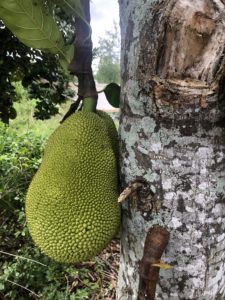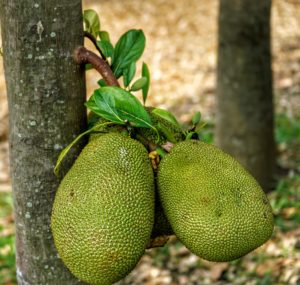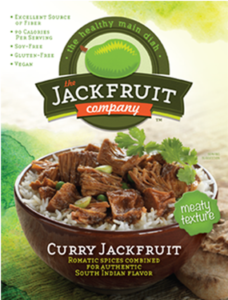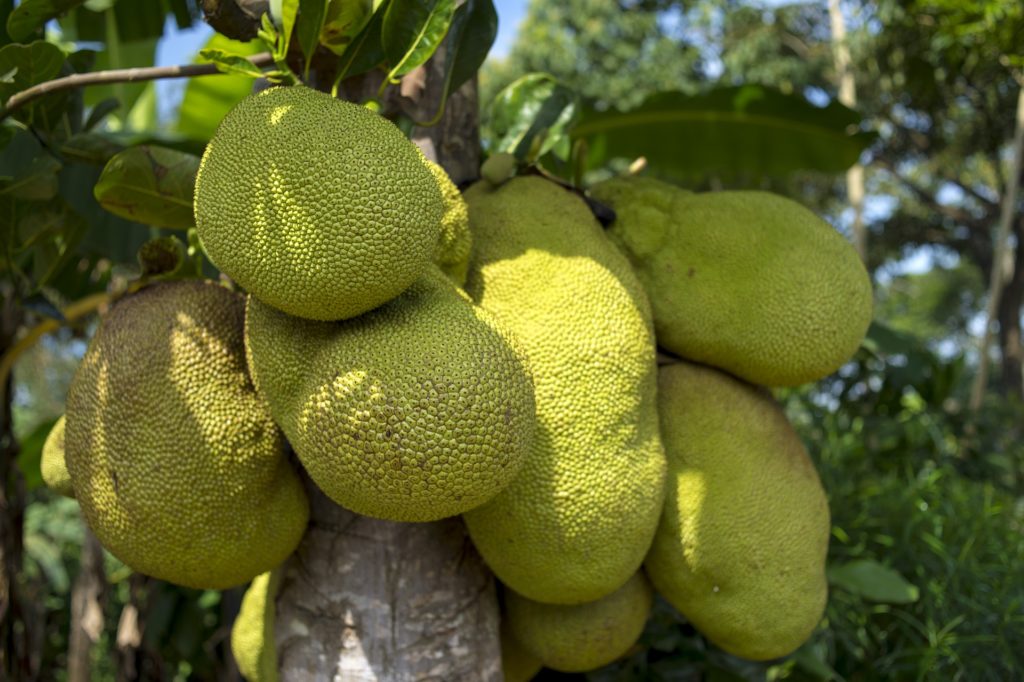Miami is able to surprise continuously. A city that has a rather luxuriant and evergreen vegetation. The tropical climate allows the growth of numerous plant species, even rather particular ones. In this article I would like to present a fruit that really struck my curiosity due to its size, its unexpected health properties and the fact that the fruit grows directly from the trunk.

The jackfruit, whose scientific name is Artocarpus heterophyllus, is a tropical plant belonging to the Moraceae family. It is cultivated for its fruit, the largest existing, in shape and size, among those that grow from trees.
In Italian it is called “giaca” (from the Portuguese “jaca”) or “catala”, in Asia it is called yak-fruit or jak, although the English denomination jackfruit is still widely used; which we will use throughout the article. It is considered an excellent food appreciated in various areas of the world, it can be eaten fresh or canned for export, dehydrated or fried in the form of chips. The unripe fruits, on the other hand, can be reduced to flour for the preparation of various exotic specialties. Even the large seeds can be eaten and are cooked in a similar way to chestnuts. The flavor is a mix of apple and pineapple, with a vanilla aftertaste; when cooked for over an hour it takes on a taste similar to that of roasted ham.
In 1928 O.W. Barrett wrote: “Jackfruits are so large and interesting and the trees so refined that it is difficult to explain the great lack of knowledge concerning them.” Today, thanks to numerous studies, we can make Mr. Barrett happy.

JACKFRUIT ORIGIN
No one knows the jackfruit’s true place of origin, although it is believed to be native to western rainforests. Today it is widespread at low latitudes throughout south-east Asia including India, Ceylon, southern China and Malaysia and on the northern coasts of Australia. It is common in the Philippines both wild and cultivated. In Africa it is often grown in Kenya, Uganda, ex Zanzibar. It was introduced in northern Brazil in the mid-19th century; in 1888 it was cultivated for the first time in Hawaii, although its growth is also rare in all the Pacific islands.
In 1728 a French ship carrying jackfruit trees was captured, and the plants were taken to Jamaica, where it is now very common. About 100 years later the jackfruit made its appearance here in Florida.
DESCRIPTION
The jackfruit plant has a robust stem up to 60 cm in diameter; It is an imposing tree in fact it has a height that can vary between 9 and 21 meters. Each part of this plant has a sticky white latex. The leaves are evergreen, while the flowers are small and stiff and emerge from the trunk and large branches. The fruit originates directly from the inflorescences of the trunk and main branches, which at a botanical level is described as an oval-shaped syncarp. This fruit has a length that can vary from 20 to 90 cm and a diameter that can exceed 40 cm. The weight, on the other hand, is between 4.2 and 20 kg, but in some cases, it can even reach 50 kg. Individual fruits can contain from 100 to 500 seeds, which are also edible.

This plant has also proved to be resistant to various subtropical microclimates such as southern Florida, where temperatures never drop below one degree Celsius. Its cultivation is not possible even in the most sheltered areas of the Mediterranean basin, because even if it survives temperatures of a few degrees above zero centigrade, there would be damage to the organoleptic qualities of the fruit, but above all, the production of the fruit in the tree adult would be irrelevant.
PRODUCTION
The largest producers of jackfruit are India, Bangladesh and Thailand. India is the first producer in the world with 1.4 million tons, followed by Bangladesh with 926 thousand tons and finally Thailand with 392 thousand tons per year. Production is so high that each jackfruit tree produces 10 to 20 fruits per season, and as mentioned above, each single fruit can weigh up to 50 kg.
Production however is quite limited here in South Florida, Jamaica and Hawaii.
The major producers here in and around Miami are about a dozen farms, which grow jackfruit plants for local sale. The quantity of fruit produced by these companies could not satisfy the export market, in fact they are limited only to the sale of the fresh product in the various fruit markets or inside Whole Foods supermarkets. In this supermarket chain, in addition to the fresh product made in the U.S.A. there are canned jackfruit products that are imported from other parts of the world. Two main brands are sold at Whole Foods and are “Native Forest Organic” with tin products made in Sri Lanka and “The Jackfruit Company” which instead sells ready-made products and is made in India.


Among these farms, one really struck my curiosity. The “THREE SISTER FARM” where in an article of May 12, 2016 declares to be practically the only company with organic certification in the production of jackfruit in the whole state. This farm is home to about 8 different varieties of jackfruit, which vary in texture, flavor, latex levels and even the amount of juice produced from each individual fruit. Some people have said that they have never tasted jackfruit as good as the one produced by Three Sister Farm. The reason lies in the fact that this company lets the fruit develop completely on the tree. This is unlike other companies which, in order to satisfy the final consumer, do not wait for the fruit to fully ripen on the plant and harvest it when it is still green and hard.
The fruiting season in South Florida begins around May and lasts through September.
HOW IT IS CONSUMED
Jackfruit is mainly used as a meat substitute, thanks to the nutritional properties it presents and which we will see later, so it is absolutely useful in vegan nutrition. In Miami, many people in recent years have approached this type of diet and consequently many vegan restaurants have popped up. The first 100% vegan restaurant born in Miami more precisely Miami Beach is Full Bloom Gourmet Vegan Cuisine, and of course they offer jackfruit dishes on their menu. One of the three owners (all three Italians) Alessandro had the great kindness to explain something to me about the consumption and use of this fruit in their cuisine.
Alessandro begins like this: “The jackfruit in our kitchen is a very important ingredient, as our customers, both vegan and non-vegan, like it very much. Whenever possible we use fresh fruit that we buy directly from local farms. Unfortunately, fresh jackfruit is only available for about 3-4 months of the year from June to September and considering the very high demand from our customers regarding these dishes, for the remaining months of the year we use the already peeled fruit and ready to cook, always with the utmost certainty that they are high quality and organic products. The most successful dishes based on jackfruit are the “ropa vieja”, “jackfruit curry” and “jackfruit tacos”. The “ropa vieja” is a dish of Cuban origin where there is pork, we obviously use the jackfruit cooked in tomato sauce and where the finished dish is presented on a bed of black rice accompanied by peppers, olives and capers. The “jackfruit curry” a dish of Indian and Thai origin based on fish or chicken, in this case the jackfruit is cooked in the oven so that it has a soft texture inside and crunchy on the outside and then served with seasonal vegetables in a cream of coconut milk and curry, accompanied by green rice. Finally, the “jackfruit tacos” are of Mexican origin and the jackfruit in this case is cooked in a very similar way to carne asada, therefore salty, peppery and well-cooked on the grill or in a pan and then accompanied with various vegetables.” He concludes by expressing himself in this way: “This fruit has many properties, it is low in calories and contains many vitamins and minerals; therefore, it is a very interesting ingredient to use in the kitchen and an excellent substitute for meat. It is also absolutely suitable for those who do not follow a vegan diet and I hope more people can approach a completely cruelty-free lifestyle.”
JACKFRUIT AS FUNCTIONAL FOOD
There is no recognized definition of functional food. This term has been defined several times, but there is still no unified acceptance for the categorization of this food group. In most countries there is no legal definition, and drawing the line between conventional food and functional food is difficult even for nutritionists and food experts. In the USA, functional food is not officially recognized as a category by the FDA. The IFIC (International Food Council) considers functional foods those that include components that can benefit health in addition to the nutritional basis. The Institute of food technologists (IFT) also made a similar statement.
Functional food components provide essential nutrients, often in addition to amounts for normal functioning, growth and development, and/or other biologically active components that are beneficial to health.
The very concept of food is changing from a past emphasis on maintaining health, to the promising use of “foods” that can promote better health and prevent chronic disease.
| Jack fruit (Artocarpus heterophyllus), Nutritive Value per 100 g. (Source: USDA National Nutrient data base) | ||
| Principle | Nutrient Value | Percentage of RDA |
| Energy | 95 Kcal | 5% |
| Carbohydrates | 23.5 g | 18% |
| Protein | 1.72 g | 3% |
| Total Fat | 0.64 g | 3% |
| Cholesterol | 0 mg | 0% |
| Dietary Fiber | 1.5 g | 4% |
| Vitamins | ||
| Folates | 24 µg | 6% |
| Niacin | 0.920 mg | 6% |
| Pyridoxine | 0.329 mg | 25% |
| Riboflavin | 0.055 mg | 4% |
| Thiamin | 0.105 mg | 9% |
| Vitamin A | 110 IU | 3.5% |
| Vitamin C | 13.7 mg | 23% |
| Vitamin E | 0.34 mg | 2% |
| Electrolytes | ||
| Sodium | 3 mg | 0% |
| Potassium | 303 mg | 6.5% |
| Minerals | ||
| Calcium | 34 mg | 3.4% |
| Iron | 0.60 mg | 7.5% |
| Magnesium | 37 mg | 9% |
| Manganese | 0.197 mg | 8.5% |
| Phosphorus | 36 mg | 5% |
| Phosphorus | 21 mg | 3% |
| Selenium | 0.6 mg | 1% |
| Zinc | 0.42 mg | 4% |
| Phyto-nutrients | ||
| Carotene-ß | 61 µg | — |
| Crypto-xanthin-ß | 5 µg | — |
| Lutein-zeaxanthin | 157 µg | — |
Today, there is much interest within the scientific community regarding the functional properties of jackfruit.
Jackfruit therefore can be considered a functional food as it has high amounts of nutrients in different parts of the fruit that show medicinal and functional effects.
Various scientific studies have reported that this fruit can be useful for example in improving skin health thanks to the presence of vitamin C; it can improve digestion thanks to the presence of fibers and the high magnesium content can be useful in strengthening bones. Furthermore, as shown in the table, it is a good source of carbohydrates and vitamins, and fair source of proteins and thanks to its few calories and a very low amount of fat, it is ideal for individuals following low-calorie diets.
Some popular beliefs here in South Florida say that the latex produced by the plant when mixed with vinegar can heal abscesses, snake bites and glandular swellings. The leaves when heated are useful for healing wounds or the ash obtained by burning the leaves with corn and coconut shells is useful for healing ulcers. And finally, the roasted seeds are considered an aphrodisiac.
The consumption of this gigantic and curious fruit has grown a lot in recent years, thanks also to the numerous discoveries on the benefits it can bring to health. Indeed, the rich bioactive profile makes it a super nutritious and very desirable fruit, even for those who choose a vegan diet. Scientific studies on both the nutritional and health profile are still ongoing. Jackfruit as we described in the article is a very particular fruit that managed to surprise me, not only for its size but also for its properties; this convinces me more and more that nature always has something to teach us.

Dr. Mara Bianchini, B.S.
Holistic Therapist, Herbalist, Nutritionist, Reiki Master


